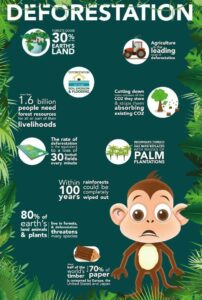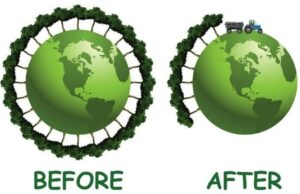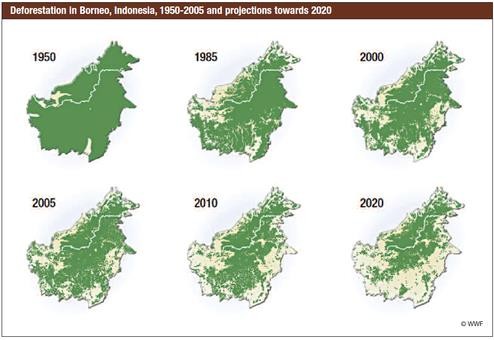Deforestation is one of the major issues being faced by environment. Deforestation, is clearing or thinning of forests. Different factors, either of human or natural origin, cause deforestation. Natural factors include natural forest fires or parasite-caused diseases which can result in deforestation. Nevertheless, human activities are among the main causes of global deforestation.

According to the Food and Agriculture Organization (FAO), the expansion of agriculture caused nearly 80% of global deforestation, with the construction such as roads or dams, together with mining activities and urbanization, making up the remaining causes of deforestation.
Throughout history and into modern times, forests have been destroyed to make space for agriculture, animal grazing, to obtain wood for fuel, manufacturing and construction. Deforestation has greatly altered landscapes around the world. Already in year 2000, half of the world’s rainforest had been wiped out. If the rate of deforestation continues, we will have no rainforests left at the end of the century. When you see paper and wood, what do you think of? Do you think of the tree that was chopped to make the product? Before we started to build cities many centuries ago, they say that 60% of the Earth was covered in Forests.

Now, there is less than 10% left. About 2,000 years ago, 80 percent of Western Europe was forested; today the figure is 34 percent. In North America, about half of the forests in the eastern part of the continent were cut down from the 1600s to the 1870s for timber and agriculture.
China has lost great expanses of its forests over the past 4,000 years and now just over 20 percent of it is forested.
Countries with Highest Rates of Ongoing Deforestation. Deforestation is a severe issue in many regions of the world. Some countries are cutting down their forests at alarming rate. As per “earthandhuman.org” list of those countries that are still cutting down trees is topped by following: –
a. Ethiopia.
b. Cambodia.
c. Indonesia.
Ethiopia. In Ethiopia, deforestation refers to inhabitants removing trees for personal purposes such as fuel, hunting and agriculture. Shifting agricultural, livestock production and fuel production to drier locations are the primary drivers of deforestation in Ethiopia. Ethiopia used to be environmentally and culturally ironic country. However, this rich environmental and cultural legacy is in danger, mainly due to deforestation. Ethiopia has Africa’s second-largest population and has experienced famine on several occasions owing to water shortages and natural resource depletion. Deforestation may have contributed to the already low rainfall levels. Forests in Ethiopia play a big role in protecting erosion, as tree roots protect against soil erosion. Trees also help to keep water in the soil and reduce global warming by uptake of carbon dioxide. Because there are not enough trees, the Blue Nile is carrying all the soil and nutrients in the water to the neighboring countries of Sudan and Egypt. Keeping in view estimates for deforestation in different regions of Ethiopia, the country will have lost its last tree of high forests within about 27 years. And with it will go the world’s only original wild populations of Coffea Arabica. The economic loss of that genetic resource ranges between 0.4 and US$1.5 billion/year.

Impacts of Resettlement Programs on Deforestation of Moist Evergreen Afromontane Forests in Southwest Ethiopia.
Cambodia: According to analysis from Forest Trends, Cambodia’s natural forests are disappearing at a pace of around 208,000 hectares (804 square miles) every year. Land concessions provided by the government are being used only to clear-cut portions of Cambodia’s oldest and most precious surviving forests to meet agricultural development obligations. In 1999, Cambodia’s total forest area was 11 million hectare, which stored 150 tons of carbon each, resulting in Cambodia’s forest storing 1.6 billion tons of carbon per year.

With every 100,000 hectare of deforestation, 15 million tons of carbon will remain in the atmosphere. Decrease in forest cover contributes to erosion, flooding, and siltation of streams which compromises water currents which directly support the livelihoods of the Cambodian people.
Indonesia: Indonesia was formerly wholly covered in forest, and roughly 65 percent of the forest cover persists across the country, with about 29 percent in a border forest state. However, it has lost many forests cover over the last two decades.
As late as 1900, Indonesia was still a densely forested country: forests represented 84 percent of the total land area. Deforestation intensified in the 1970s and has accelerated further since then. The estimated forest cover of 170 million hectares around 1900 decreased to less than 100 million hectares by the end of the 20th century.

Rapid and increasing deforestation harms Indonesia’s broad biodiversity and drives Indonesia’s greenhouse gas emissions, which are among the world’s highest. The conversion and burning of peat soils causes severe air pollution, presenting major public health harms.
One of the critical causes of global warming is the rising rate of deforestation. Forest preservation also aids in the prevention of floods and droughts by moderating regional rainfall. Because many indigenous and forest peoples rely on tropical forests for their livelihoods, investments in preventing deforestation provide them with the resources they require for long-term development. Hence, all the countries listed and not listed should be aware and preserve the forest.

Hooriya Basit
Class IV B
